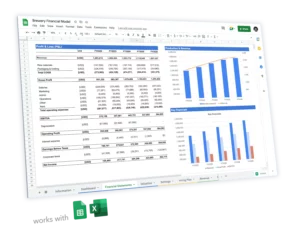How to Write a Brewery Business Plan: Complete Guide
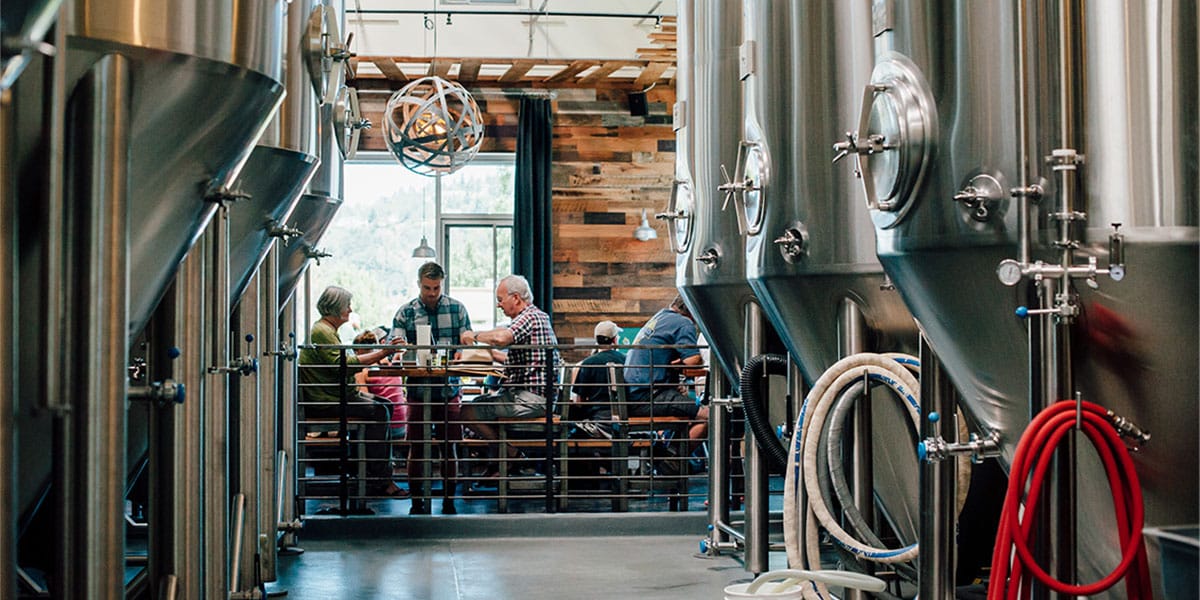
Whether you’re looking to raise funding from private investors or to get a loan from a bank (like a SBA loan) for your brewery, you will need to prepare a solid business plan.
In this article we go through, step-by-step, all the different sections you need in the business plan of your brewery. Use this template to create a complete, clear and solid business plan that get you funded.
For more information on breweries, make sure to read our guides below: How to Start a Brewery in 9 Steps: Complete Guide How Much Does It Cost To Start A Brewery? How To Build A Financial Model For a Brewery 10 Strategies To Increase Your Brewery Sales & Profits
1. Executive Summary
The executive summary of a business plan gives a sneak peek of the information about your business plan to lenders and/or investors.
If the information you provide here is not concise, informative, and scannable, potential lenders and investors will lose interest.
Though the executive summary is the first and the most important section, it should normally be the last section you write because it will have the summary of different sections included in the entire plan.
Why do you need a business plan for a brewery?
The purpose of a business plan is to secure funding through one of the following channels:
- Obtain bank financing or secure a loan from other lenders (such as a SBA loan)
- Obtain private investments from investment funds, angel investors, etc.
- Obtain a public or a private grant
How to write your brewery’s executive summary?
Provide a precise and high-level summary of every section that you have included in your business plan. The information and the data you include in this segment should grab the attention of potential investors and lenders immediately.
Also make sure that the executive summary doesn’t exceed 2 pages in total: it’s supposed to be a summary for investors and lenders who don’t have time to scroll through 40-50 pages, so keep it short and brief.
The executive summary usually consists of the five major sub-sections that include:
- Business overview: this segment will provide a high-level summary of your business and the products you will sell. For example, mention the type of brewery you want to open (such as microbrewery, brewpub, taproom brewery, regional brewery, contract brewing company, etc.). Also, briefly mention your products and services (if you offer a sit-in taproom for example) and pricing strategy
- Market analysis: summarise the market where you will operate and provide a brief about the target audience, market size, competitors, etc. No need to provide granular data here, save it for the Market Overview section later on (or the appendix). You must provide only scannable data points to keep potential investors and/or lenders hooked.
- People: introduce your brewery’s management and employee structure. Provide a brief (no more than a couple of sentences each) of the knowledge and experience of the team. Also, speak about your hiring plans.
- Financial plan: how much profit and revenue do you expect in the next 5 years? When will you reach the break-even point and start making profits? You can include here a chart depicting your key financials such as revenue, gross profits, and net profit
- Funding ask: what loan/investment/grant are you seeking? How much do you need? How long will this last?
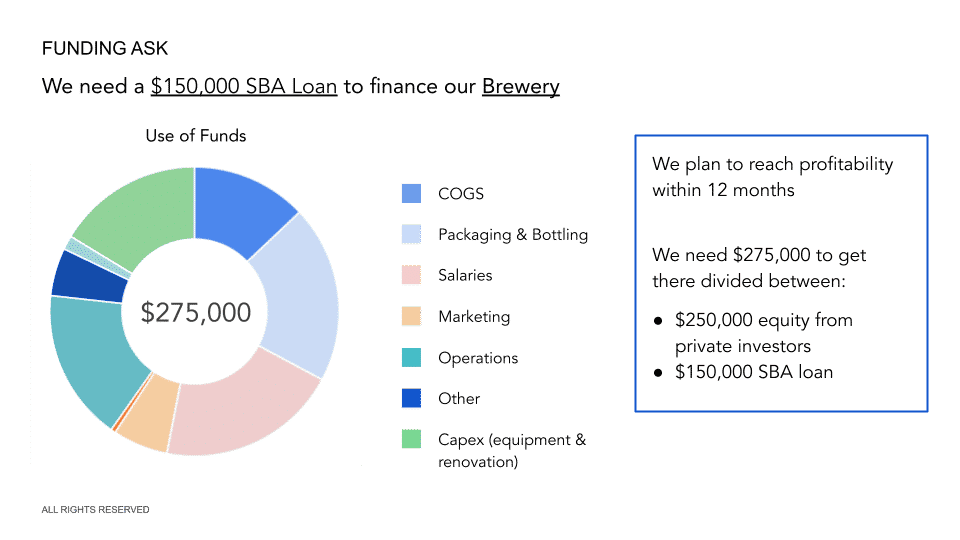
2. Brewery Business Overview
This is the section where you will provide details about your brewery and the chosen business model. You must address some important questions that lenders and/or investors generally ask. Here is a quick list of some of those questions you must address:
- What’s the brewery’s location and why did you select that location?
- Why did you select the type of brewery you want to open?
- What will be the beer products you will offer? Any other drinks or services?
- What will be your pricing strategy and why?
- Who is your target audience?
- How many customers can you serve at once (in case you are going for options like taproom brewery or brewpub)?
- What will be the legal structure of your company?
Let’s look at different subsections that you must include:
a) History of the Project
Any business must have two components:
- Passion & experience of the business owner
- Rationale behind starting this type of business today
Passion & experience
You may or may not have prior experience. If you have experience, speak about it and how it will help you to run your business. For instance, you may have been a brewmaster in a popular brewery for 12 years, and now you want to start your own brewery and use your knowledge to run it more efficiently.
However, if you don’t already have experience, that’s fine. You must demonstrate your passion and some industry knowledge that you have acquired through intensive research.
Rationale
Is there a certain problem (or perhaps, a set of problems) that your brewery will try to solve when it comes into existence? For instance, there may not be any brewpub in the area, and you want to capitalize on the opportunity.
However, you must understand that the market must be suitable for the business. For instance, if the target audience in the location prefers a taproom brewery, offering a brewpub instead may not be a wise decision.
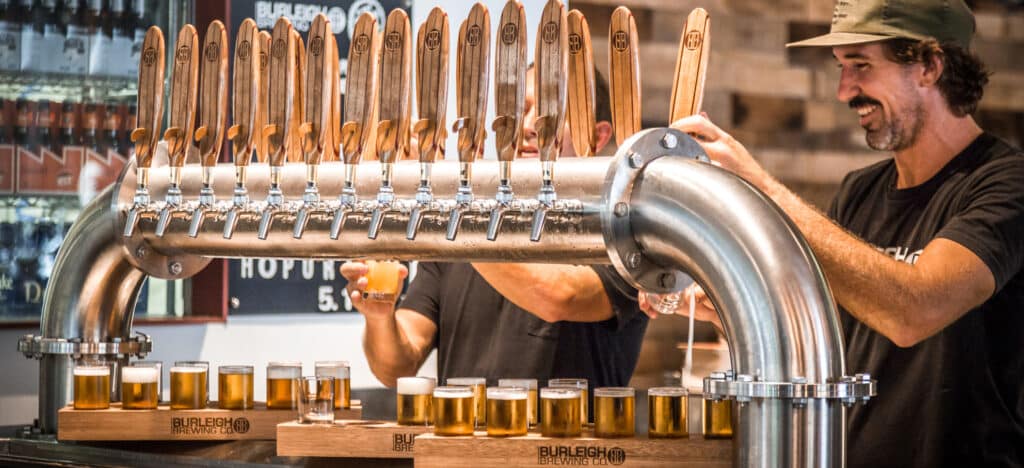
b) Business Model
This sub-section of the Business Overview will explain your business model. Describe the following points briefly:
- Will you buy an existing brewery and do some remodeling, or will you start a new brewery and design it from scratch?
- The type of brewery you want to open and why
- Equipment, inventory, and storage facilities that are essential for the brewery to operate successfully
There are multiple types of breweries that you can consider:
- Nano brewery: This is the smallest type of brewery. There are no defined barrels per annum, but they produce a very limited amount of beer per year
- Microbrewery: This type of brewery will produce less than 15,000 barrels of beer a year. Most beer is sold onsite instead of using distributors. These breweries are typically independently owned
- Brewpub: A restaurant and brewery hybrid in which the beer produced is served to the bar customers
- Taproom brewery: These are professional breweries that sell beer onsite and even via distributors. However, there are no restaurant services available. Sometimes, such breweries will have attached taprooms
- Regional brewery: These are breweries that produce anywhere between 15,000 and 600,000 barrels of beer a year
- Contract brewing company: In this form, a company will hire other breweries for beer production and packaging. However, the marketing and distribution of the beer will be the responsibility of the hiring company
The type of brewery that you want to open will depend on its market size, target audience, your business expansion plans, etc. For instance, if you want to sell your products outside of your state, you may want to go for a regional brewery or perhaps, settle for a contract brewing company.
c) Products & Services
Since you want to start a brewery, you will obviously be selling beer. However, you may decide to make different flavors. Also, if you want to open a brewpub, you may also be running a full-scale restaurant and serving food to your customers.
Depending on the type of brewery you will open, you must list all the products and services that you will sell. For example, if you are selling packaged snacks (taproom brewery) or instead if you want to have a full-service kitchen (brewpub), mention the relevant products here.

d) Pricing Strategy
In this segment, you must explain your pricing strategy. The price of the beer will depend on the product itself and its manufacturing complexity. Even the raw materials and the scale of your business will also determine the pricing.
If you are creating a premium line of products with a higher price tag, make sure that there is a proper justification for that.
It is a good practice to include a pricing chart for all possible products if you have a small menu. However, if you are offering many products, provide a sample menu with the pricing range.
3. Brewery Market Overview
A complete understanding of the market where you want to operate is important for the success of your business.
For example, if you want to open your brewery in an affluent area where people don’t mind spending extra in exchange for a unique craft beer, a specialty taproom brewery may be a successful business.
Therefore, you must cover here 3 important areas:
- Brewery Industry Status Quo: how big is the brewery industry in your area? What is its growth rate (or decline rate) and what are the factors contributing to its growth or decline?
- Competition overview: how many competitors are there? How do they compare vs. your business? How can you differentiate yourself from them?
- Customer analysis: who is your target audience? What type of breweries do they prefer? How regularly do they visit breweries? Do they prefer to sit and eat in a brewery, and if so, do they prefer brewpubs or do they prefer taproom breweries? How much do they spend on average?
a) Brewery Industry Status Quo
How big is the brewery industry in the US?
According to Brewers Association, the overall beer market in the US is $100 billion, while craft beer accounted for 27% market share ($26.8 billion).
After a decline of 9% in 2020, primarily due to the COVID-19 pandemic, the beer industry bounced back by 8% in 2021.
However, what’s interesting is that the overall number of breweries in the U.S. increased in 2021 and reached an all-time high of 9,247 breweries (+2.5% vs. 2021) of which the breakdown (in terms of production volume) is shown below:

How big is the brewery industry in your area?
Once you provide the overall picture of the US, divert your attention to the area where you want to operate. It might not be possible to find region or area-specific studies, and hence, you must estimate the size of your market yourself. For more information on how to do so, read our article on how to estimate TAM, SAM and SOM for your startup.
For example, there were 9,247 craft breweries in the US accounting for $26.8 billion in sales. Hence, the average annual revenue for each craft brewery stood at about $3,000,000.
Therefore, if there are 18 craft breweries in your area (city or region), the overall brewery market size is approximately $54 million.
How fast is the brewery industry growing in the area?
After market size, you must look into the growth rate of the brewery industry in your area. This information may not be available via online research papers. However, assessing the growth rate of the brewery industry can be assessed using the number of competitors in the area.
For instance, if there were 13 breweries in 2018 and 18 breweries in 2022, the average annual growth rate of the brewery market in your area is 8.3%.

What are the current brewery market trends in your area?
It is vital to understand the trends of the brewery industry in your area. Understanding trends will allow you to devise marketing strategies.
Understanding trends won’t be easy. You must conduct research and talk with your target audience. Additionally, you must also study your competitors to understand their target audience, the products they sell, etc.
Some common questions you may ask the target audience include:
- What type of breweries do they prefer?
- At what time of the day do they prefer to visit a brewery (evening, afternoon, late night)?
- How frequently do they visit breweries?
- What type of foods do they usually order along with beer (if they are going for taprooms having a partnership with food trucks or they are opting for brewpubs)?
You can ask as many questions as you need to understand the evolving trends.
b) Competition Overview
Studying your competitors’ business models is vital. You need to understand what makes them successful or why they fail. A clear understanding of their brew offerings, marketing strategies, etc., will allow you to provide a better service.
If your competitors are offering nearly the same products & services, then what is their market share and how do they market their products & services to attract new customers?
It is always a good idea to do some research (if necessary, physically visit your competitors without revealing your business intentions) and create a comparative table summarizing their product & service offerings, marketing strategies, target audience, etc.
Here is a sample table that you can use:
| Competitor #1 | Competitor #2 | Competitor #3 | |
|---|---|---|---|
| Location | xx | xx | xx |
| Business model (brewery type) | Regional craft brewery | Tap brewery | Brewpub |
| Type of beers | xx | xx | xx |
| Customers | Resellers, retail restaurants, hotels | Resellers, restaurants, hotels, individuals | Individuals |
| Other products offered | None | None | Food, snacks |
| Sales & Marketing strategy | Signage Sales Reps | Signage Sales Reps Email marketing Digital channels (reviews, banner ads, etc.) | Signage Social media outreach Email marketing Digital channels (reviews, banner ads, etc.) |
| Google Rating | 4.2 (187+) | 4.6 (686+) | 4.8 (1,034+) |
| Pricing structure (per barrel) | xx | xx | xx |
| Brewery size | 3,000 sq. ft. | 4,500 sq. ft. | 3,700 sq. ft. |
| Staff | 14 | 20 | 15 |
The table you will create will depend on what information you need and want to include based on your proposed business model.
Brewery SWOT Analysis
It’s always good practice to provide a SWOT analysis as part of the business plan for your brewery. It must be crisp and highly focused. SWOT stands for Strength, Weakness, Opportunities, and Threats.
Here is a sample that you can use as a reference:
- Strengths: 8 years of brewmaster experience in a reputed large (non-craft) brewery
- Weaknesses: Startup cost, zero reputation
- Opportunities: An affluent neighborhood with rising demand for a brewpub, no brewpub in a 2-mile radius
- Threats: Increasing cost of raw materials, mass-production beer manufacturers are flooding the market
A clear understanding of your strengths and weakness along with opportunities and threats in the real market can help you to design your marketing strategy. It also helps potential investors to assess the risk and reward profile of your business and is often a must have in your brewery business plan.

c) Customer Analysis
This is the sub-section where you will provide a detailed analysis of your target audience. You will expand the data points your provided earlier in the Business Overview segment.
Some important points that you must include in your customer analysis include:
- Age and gender distribution (you can get local demographic data from census.gov)
- Per capita expenditure on beer
- Frequency of brewery visits
- Average monthly income and disposable income
- Average bill size per visit
- Average yearly or monthly spending on breweries
- Type of breweries preferred
- The expected price range for brews
- Inclination towards loyalty programs
- Things they dislike about existing breweries and what they expect to be improved
You can add as many data points as required to validate your business decision. The idea here is to display your deep understanding of the target audience and their needs, preferences, and expectations. This knowledge can help you to tailor your products & services to attract new customers.
4. Sales & Marketing Strategy
This is the segment where you outline the customer acquisition strategy of your brewery. Try to answer the following questions:
- What is your USP?
- What are the different marketing strategies you will use?
- How do you intend to track the success of your marketing strategy?
- What is your CAC or customer acquisition cost?
- What is your marketing budget?
- What introductory promos and offers do you intend to provide for attracting new customers?
Let’s expand a bit on a few questions below:
What marketing channels do breweries use?
Marketing channels are ways of communication businesses use to attract customers. Logically, not all breweries use the same marketing channels. For example, a taproom that sells craft beer will most likely rely more on social media and signage vs. a regional brewery that only sells to resellers, restaurants, bars and other business customers (they will likely use a sales team instead, along with some paid media, print ads in specialized magazines, etc.).
See below a few examples of marketing channels that breweries typically use:
- Signage
- Sales representatives (only breweries selling to businesses)
- PPC ads, Facebook ads, etc.
- Customer interaction through social platforms like Instagram, Facebook, etc.
- Email marketing
- Loyalty programs
- Word of mouth, recommendations
Of course, it’s not mandatory to use all channels. Instead, you can start by focusing on a few of them, and add others as you scale up later on.
Also, you must have a fair and nearly accurate estimate of your marketing budget. Failure to display a well-planned and adequate cash flow for advertising and marketing can lead to investors losing confidence. That’s because investors are fully aware that if adequate funds are not allocated for marketing, the business will be derailed before becoming a success.

What is your unique selling proposition?
In other words, how do you differentiate yourself vs. competitors? This is very important as you might need to win customers from competitors. A few examples of USPs are:
- Quality of beer products: your craft beer(s) may be of higher quality (raw materials r transformation) vs. your competitors’
- Location: your brewery may be located closer to your customers, reducing transport costs for your customers
- Partnerships: you may have partnered with famous brands, bars, restaurant chains or franchises your customers are fond of
- Price: your beer products (and/or food if you have a brewpub) may be cheaper vs. competitors
- Extra products / services: you may be the only brewpub in the area offering food to your customers, whilst all other competitors only offer taprooms
Your USP will depend on your business model, competitor analysis, target audience, and product. The idea is to speak to customers’ emotions and needs. Whatever your USP be, it should appeal to your potential customers and attract them. Plus, The USP you offer should be convincing enough for investors and lenders.
5. Management & People
You must address two things here:
- The management team and their experience/track record
- The organizational structure: different team members and who reports to whom?
a) Management
Small businesses often fail because of managerial weaknesses. Thus, having a strong management team is vital. Highlight the experience and education of senior managers that you intend to hire to oversee your brewery business.
Describe their duties, responsibilities, and roles. Also, highlight their previous experience and explain how they succeeded in their previous roles.
It is also important that you explain how their experiences and qualifications help you in implementing the brewery you are proposing. If they have specialized training, and experience (such as a certificate in brewing technology covering concepts like wort production, fermentation, etc.; brewmaster experience, etc.), add that information.
b) Organization Structure
Even if you haven’t already hired a brewer, head brewer (or brewmaster), tasting staff, tasting room manager, marketing personnel, quality control personnel, and other relevant staff members, you must provide a chart of the organizational structure defining the hierarchy of reporting.
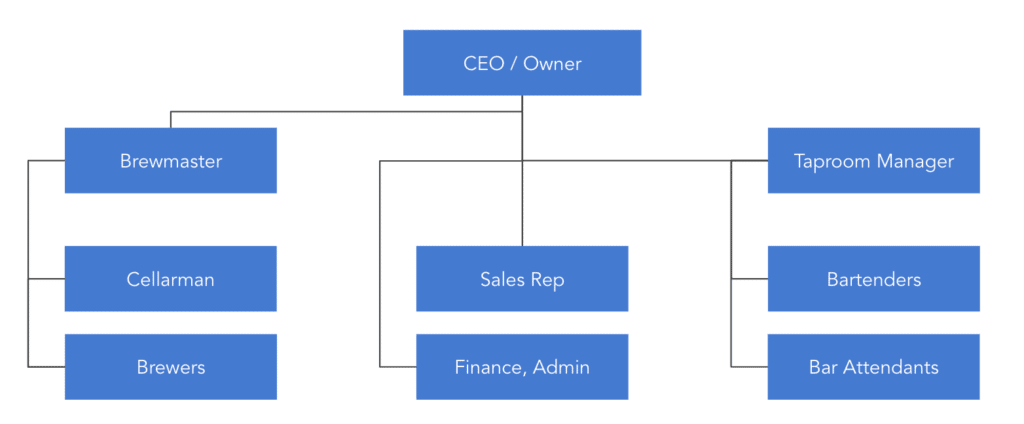
6. Financial Plan
The financial plan is perhaps, with the executive summary, the most important section of any business plan for a brewery.
Indeed, a solid financial plan tells lenders that your business is viable and can repay the loan you need from them. If you’re looking to raise equity from private investors, a solid financial plan will prove them your brewery is an attractive investment.
There should be 2 sections to your financial plan section:
- The startup costs of your project (if you plan to start a new brewery, purchase new equipment, renovate your brewery, add a taproom to your brewery, etc.)
- The 5-year financial projections
a) Startup Costs
Before we expand on 5-year financial projections in the following section, it’s always best practice to start with listing the startup costs of your project. For a brewery, startup costs are all the expenses you incur before you open your brewery and start making sales. These expenses typically are:
- The brewing systems and other equipment
- The leasing deposit for the space (if you rent) or to buy the real estate (if you buy)
Logically, brewery startup costs vary significantly based on factors like the size of your brewery, its capacity (in barrels), its location, the quality of equipment, etc.
On average, it costs $158,000 to $340,000 to start a 2,000 barrel craft brewery.
Note that these costs are for illustrative purposes and may not be fully relevant for your business. For more information on how much it costs to open and run a brewery, read our article here.
| Startup cost | Amount |
|---|---|
| Machinery and equipment | $150,000 – $250,000 |
| Licenses | $5,000 – $75,000 |
| Software and Point Of Sale System (POS) | $1,000 – $5,000 |
| Marketing | $2,000 – $10,000 |
| Total | $158,000 – $340,000 |
b) Financial Projections
In addition to startup costs, you will now need to build a solid 5-year financial model for your brewery.
Your financial projections should be built using a spreadsheet (e.g. Excel or Google Sheets) and presented in the form of tables and charts in the business plan of your brewery.
As usual, keep it concise here and save details (for example detailed financial statements, financial metrics, key assumptions used for the projections) for the appendix instead.
Your financial projections should answer at least the following questions:
- How much revenue do you expect to generate over the next 5 years?
- When do you expect to break even?
- How much cash will you burn until you get there?
- What’s the impact of a change in pricing (say 15%) on your margins?
- What is your average customer acquisition cost?
You should include here your 3 financial statements (income statement, balance sheet and cash flow statement). This means you must forecast:
- The number of barrels you produce over time ;
- The number of beers (or barrels) you sell ;
- Your expected revenue ;
- Operating costs to run the business ;
- Any other cash flow items (e.g. capex, debt repayment, etc.).
When projecting your revenue, make sure to sensitize pricing, cost of raw materials (malt, hops, packaging, etc.) and your sales volume. Indeed, a small change in these assumptions may have a significant impact on your revenues and profits.

7. Funding Ask
This is the last section of the business plan of your brewery. Now that we have explained what your brewery business model is, what types of beer you sell and to whom (individuals vs. businesses), what’s your marketing strategy, etc., this section must now answer the following questions:
- How much funding do you need?
- What financial instrument(s) do you need: is this equity or debt, or even a free-money public grant?
- How long will this funding last?
- Where else does the money come from? If you apply for a SBA loan for example, where does the other part of the investment come from (your own capital, private investors?)
If you raise debt:
- What percentage of the total funding the loan represents?
- What is the corresponding Debt Service Coverage Ratio?
If you raise equity
- What percentage ownership are you selling as part of this funding round?
- What is the corresponding valuation of your business?
Use of Funds
Any brewery business plan should include a clear use of funds section. This is where you explain how the money will be spent.
Will you spend most of the loan / investment in paying your employees’ salaries? Or will it cover mostly the cost for the lease deposit and the renovation?
Those are very important questions you should be able to answer in the blink of an eye. Don’t worry, this should come straight from your financial projections. If you’ve built solid projections like in our Brewery financial model template, you won’t have any issues answering these questions.
For the use of funds, we also recommend using a pie chart like the one we have in our financial model template where we outline the main expenses categories as shown below.


